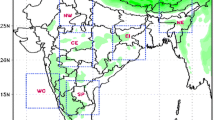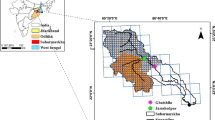Abstract
The southwest (SW) monsoon season (June, July, August and September) is the major period of rainfall over the Indian region. The present study focuses on the development of a new multi-model ensemble approach based on the similarity criterion (SMME) for the prediction of SW monsoon rainfall in the extended range. This approach is based on the assumption that training with the similar type of conditions may provide the better forecasts in spite of the sequential training which is being used in the conventional MME approaches. In this approach, the training dataset has been selected by matching the present day condition to the archived dataset and days with the most similar conditions were identified and used for training the model. The coefficients thus generated were used for the rainfall prediction. The precipitation forecasts from four general circulation models (GCMs), viz. European Centre for Medium-Range Weather Forecasts (ECMWF), United Kingdom Meteorological Office (UKMO), National Centre for Environment Prediction (NCEP) and China Meteorological Administration (CMA) have been used for developing the SMME forecasts. The forecasts of 1–5, 6–10 and 11–15 days were generated using the newly developed approach for each pentad of June–September during the years 2008–2013 and the skill of the model was analysed using verification scores, viz. equitable skill score (ETS), mean absolute error (MAE), Pearson’s correlation coefficient and Nash–Sutcliffe model efficiency index. Statistical analysis of SMME forecasts shows superior forecast skill compared to the conventional MME and the individual models for all the pentads, viz. 1–5, 6–10 and 11–15 days.





Similar content being viewed by others
References
Barnston AG, Mason SJ, Goddard L, DG DW, Zebiak SE (2003) Multimodel ensembling in seasonal climate forecasting at IRI. Bull Am Meteorol Soc 84:1783–1796
Bhomia S, Jaiswal N, Kishtawal CM, Kumar R (2015) Multi-model prediction of monsoon rain using dynamical model selection. IEEE, TGRS 54(5):2911–2917. doi:10.1109/TGRS.2015.2507779
Bhowmik SKR, Durai VR (2012) Development of multimodel ensemble based district level medium range rainfall forecast system for the Indian region. J Earth Syst Sci 121(2):273–285
Cane D, Milelli M (2010) Multimodel superensemble technique for quantitative precipitation forecasts in piemonte region. Natural Hazards Earth Syst Sci 10(2):265–273
Deb SK, Kishtawal CM, Pal PK, and Joshi PC (2008) A modified tracer selection and tracking procedure to derive winds using water vapor imagers, DOI: 10.1175/2008JAMC1925.1
Durai VR, Bhardwaj R (2013) Improving precipitation forecasts skill over India using a multi-model ensemble technique. Geozika 30(2):119–141
Gilbert GK (1884) Finley’s tornado predictions. Am Meteorol J 1:166–172
Hagedorn R, Buizza R, Hamill TM, Leutbecher M, Palmer TN (2012) Comparing TIGGE multi-model forecasts with reforecast-calibrated ECMWF ensemble forecasts. Quart J Royal Meteor Soc 138:1814–1827
Joseph PV, Eischeid JK, Pyle RJ (1992) Interannual variability of the onset of the Indian summer monsoon and its association with atmospheric features, El Nino, and sea surface temperature anomalies. Am Meteorol Soc 7:81–106
Kang IS, Lee J, Park CK (2004) Potential predictability of summer mean precipitation in a dynamical seasonal prediction system with systematic error correction. J Clim 17:834–844
Kang IS, Shukla J (2005) Dynamical seasonal prediction and predictability of monsoon. In: Wang B (ed) The Asian monsoon. Praxis Publishing Ltd, Chichester, pp 585–612
Krishna Kumar K, Rupa Kumar K, Ashrit R, Deshpande NR, Hansen JW (2004) Climate impacts on Indian agriculture. Int J Climatol 24:1375–1393
Krishnamurti TN, Kishtawal CM, Shin DW, Williford CE (2000a) Improving tropical precipitation forecasts from a multi-analysis superensemble. J Clim 13:4217–4227
Krishnamurti TN, Kishtawal CM, Shin DW, Williford CE (2000b) Multi-model superensemble forecasts for weather and seasonal climate. J Clim 13:4196–4216
Krishnamurti TN, Kishtawal CM et al (1999) Improved weather and seasonal climate forecasts from multimodel superensemble. Science 285:1548–1550
Krishnamurti TN, Mishra AK, Chakraborty A, Rajeevan M (2009) Improving global model precipitation forecasts over India using downscaling and the FSU superensemble. Part I: 1–5-day forecasts. Mon Weather Rev 137:2713–2735
Krishnamurti TN, Mitra AK, Yun WT, Kumar TSVV (2006) Seasonal climate forecasts of the Asian monsoon using multiple coupled models. Tellus 58A:487–507
Krishnamurti TN, Stefanova L, Chakraborty A, Kumar TSVV, Cocke S, Bachiochi D, Mackey B (2002) Seasonal forecasts of precipitation anomalies for North American and Asian monsoons. J Meteorol Soc Jpn 80:1415–1426
Mali RR, Ranjeet S, Gupta A, Srinivasan G, Rathore LS (2006) Impact of climate change on Indian agriculture : a review. Clim Chang 78:445–478
Palmer TN, Alessandri A, Andersen U, Cantelaube P, Davey M, Délécluse P, Déqué M, Diez E, Doblas-Reyes FJ, Feddersen H et al (2004) Development of a European multi-model ensemble system for seasonal to interannual prediction (DEMETER). Bull Am Meteorol Soc 85:853–872
Palmer TN, Brankovic C, Viterbo P, Miller MJ (1992) Modelling interannual variations of summer monsoons. J Clim 5:399–417
Rajeevan M, Bhate J, Kale J, Lal B (2006) High-resolution daily gridded rainfall data for the Indian region: analysis of break and active monsoon spells. Curr Sci 91:296–306
Rajeevan M, Rohini P, Niranjan Kumar K, Srinivasan J, Unnikrishnan CK (2013) A study of vertical cloud structure of the Indian summer monsoon using CloudSat data. Clim Dyn 40:637–650
Wang B, Ding Q, Fu X, Kang IS, Jin K, Shukla J, Doblas-Reyes F (2005) Fundamental challenge in simulation and prediction of summer monsoon rainfall, Geophys. Res. Lett. 32: L15711, DOI: 101029/2005Gl022734.
Wilks DS (1995) Statistical methods in the atmospheric sciences. Academic Press, San Diego, CA, p 467
Yun WT, Stefanova L, Krishnamurti TN (2003) Improvement of the superensemble technique for seasonal forecasts. J Clim 16:3834–3840
Yun WT, Stefanova L, Mitra AK, Vijaya Kumar TSV, Dewar W, Krishnamurti YN (2005) A multi-model superensemble algorithm for seasonal climate prediction using DEMETER forecasts. Tellus 57A:280–289
Acknowledgments
Acknowledgement goes to the THORPEX Interactive Grand Global Ensemble (TIGGE) (http://tigge-portal.ecmwf.int) for providing the model output, and Indian Meteorological Department for providing rainfall data that have been used in the present study. Authors acknowledge the anonymous reviewers and the editor of the journal for their valuable comments and suggestions for improving the manuscript.
Author information
Authors and Affiliations
Corresponding author
Rights and permissions
About this article
Cite this article
Jaiswal, N., Kishtawal, C.M. & Bhomia, S. Similarity-based multi-model ensemble approach for 1–15-day advance prediction of monsoon rainfall over India. Theor Appl Climatol 132, 639–645 (2018). https://doi.org/10.1007/s00704-017-2109-6
Received:
Accepted:
Published:
Issue Date:
DOI: https://doi.org/10.1007/s00704-017-2109-6




